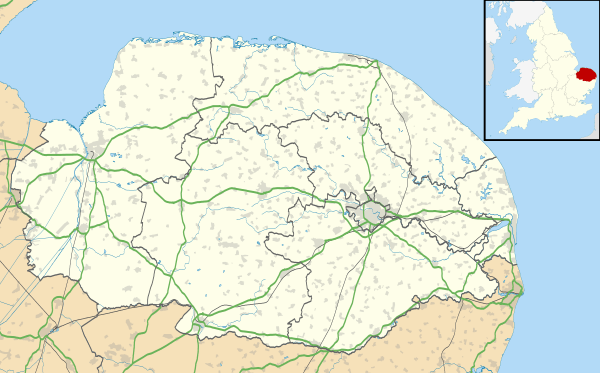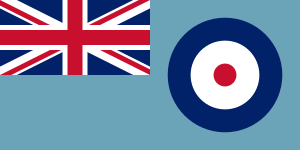RAF Swanton Morley
The former Royal Air Force Swanton Morley, more commonly known as RAF Swanton Morley, was a Royal Air Force station in Norfolk, England, located near to the village of Swanton Morley. The site is now occupied by the British Army, and is now known as Robertson Barracks.
| RAF Swanton Morley | |
|---|---|
| Near Swanton Morley, Norfolk in England | |
.jpg) The entrance to former RAF Swanton Morley during 2014 | |
 RAF Swanton Morley Location within Norfolk | |
| Coordinates | 52.728°N 0.967°E |
| Type | Royal Air Force flying station |
| Site information | |
| Owner | Ministry of Defence |
| Operator | Royal Air Force |
| Condition | Closed |
| Site history | |
| Built | 1940 |
| In use | 1940–1995 |
| Fate | Transferred to British Army and became Robertson Barracks. |
History
Swanton Morley was a new station planned under the RAF expansion scheme but not completed to the same standard before the start of the Second World War. It was part of No. 2 Group RAF in RAF Bomber Command until December 1944 when it was given over to 100 Group - the RAF unit responsible for countering German defences against the British strategic bombing - as they needed another airfield close to their HQ at Bylaugh Hall.
On 4 July 1942, American and British airmen took off from this station as part of the first combined bombing raid of World War II. No 226 Squadron had been tutoring the US 15 Bombardment Squadron. Both Winston Churchill and General Eisenhower were at RAF Swanton Morley for this mission, which saw six crews from 15th Bombardment Squadron fly a raid with six crews from the RAF, using Boston light bombers belonging to No. 226 Squadron RAF. The raid was made at low level against German airfields in the Netherlands.[1][2] During the Second World War the station was home to the Bomber Support Development Unit (BSDU) of No. 100 Group RAF.
After the Second World War the station was home to No. 1 Air Signaller's School, and the Radio Warfare Establishment RAF, which later moved to RAF Watton. At a later date Swanton Morley became home to the Central Servicing Development Establishment (CSDE) and the Maintenance Analysis and Computing Establishment (MACE).
From June 1953 to 1995 the station was also used by 611 Volunteer Gliding School, when the station was listed for closure under Options for Change.[3] The station held popular airshows during the 1980s.
The station closed on 6 September 1995. It was transferred to the British Army and the station was renamed Robertson Barracks.[4][5]
Facilities
The station was equipped with a grass surface airfield with three main runways, a perimeter track with 31 loop hardstandings, four T-type hangars, four blister hangars and one J-type hangar. The station was also equipped with a Watch Office with Met. Section, utility buildings and barracks for a total staff of 1,968 males and 390 females.[6][7]
Squadrons and other units
The following units were here at some point:
- No. 3 Squadron RAF[8]
- No. 88 Squadron RAF - Douglas Boston III, Boston IIIA (July 1941 – August 1943)
- No. 98 Squadron RAF[8]
- No. 105 Squadron RAF - Blenheims, Mosquito (October 1940 - December 1941)
- No. 107 Squadron RAF[8]
- No. 110 Squadron RAF[8]
- No. 152 Squadron RAF - Supermarine Spitfire IIA (August - December 1941)
- No. 180 Squadron RAF[8]
- No. 226 Squadron RAF - Blenheim, Boston, Mitchell (December 1941 - February 1944)
- No. 305 Polish Bomber Squadron[8]
- No. 320 (Netherlands) Squadron RAF[8]
- No. 464 Squadron RAAF[8]
- No. 487 Squadron RNZAF[8]
- No. 613 Squadron RAF[8]
- 15th Bombardment Squadron (US Eighth Air Force)[8]
- No. 1 Gliding Centre RAF[8]
- No. 2 Group Communication Flight RAF[8]
- No. 4 Radio School RAF[9] became No. 1 Air Signallers School RAF[10] became No. 1 Air Electronics School RAF[11]
- No. 5 Air Experience Flight RAF[8]
- No. 10 Air Navigation School RAF[8]
- No. 15 Blind Approach Training Flight RAF[8] became No. 1515 (Beam Approach Training) Flight RAF (October 1941 - November 1943)
- No. 17 Heavy Glider Maintenance Section RAF[8]
- No. 100 Group Communication Flight RAF[8]
- No. 102 Gliding School RAF became No. 611 Gliding School RAF[12] became No. 611 Volunteer Gliding School RAF[13]
- No. 206 Maintenance Unit RAF[8]
- No. 228 Air Stores Park RAF[8]
- No. 228 Maintenance Unit RAF[8]
- No. 1482 (Bomber) Gunnery Flight RAF[8] became No. 2 Group Support Unit RAF
- No. 1508 (Beam Approach Training) Flight RAF (September - October 1941)
- No. 1508 (Gee Training) Flight RAF[8]
- No. 2715 Squadron RAF Regiment[8]
- No. 2749 Squadron RAF Regiment[8]
- No. 2770 Squadron RAF Regiment[8]
- No. 2809 Squadron RAF Regiment[8]
- No. 2836 Squadron RAF Regiment[8]
- No. 4199 Anti-Aircraft Flight RAF Regiment[8]
- No. 4214 Anti-Aircraft Flight RAF Regiment[8]
- Pilot-Navigation Instructors Course RAF[8]
- Radio Warfare Establishment RAF[8]
References
Citations
- 24 Hours Museum - WW2 Events
- HyperWar: The Army Air Force in WW2
- 611 VGS History Archived 23 July 2008 at the Wayback Machine
- March, Peter R. (1998). Brace by Wire to Fly-By-Wire – 80 Years of the Royal Air Force 1918–1998. RAF Fairford: Royal Air Force Benevolent Fund Enterprises. p. 164. ISBN 1-899808-06-X.
- "Future of mid Norfolk barracks secured, but Light Dragoons will leave Norfolk". edp24.co.uk. Archant.
- Control Towers - Swanton Morley
- Bomber Command - Swanton Morley Archived 8 October 2008 at the Wayback Machine
- "Swanton Morley". Airfields of Britain Conservation Trust. Retrieved 26 May 2020.
- Lake 1999, p. 160.
- Lake 1999, p. 23.
- Lake 1999, p. 14.
- Lake 1999, p. 113.
- Lake 1999, p. 115.
Bibliography
- Lake, A (1999). Flying units of the RAF. Shrewsbury: Airlife. ISBN 1-84037-086-6.
External links
- Documentary on the first US/UK air raid of World War 2, flown from this station.
- "RAF Stations - S", Air of Authority - A History of RAF Organisation
- "Swanton Morley", Bomber Command 60th Anniversary, archived from the original on 8 October 2008
| Wikimedia Commons has media related to Royal Air Force. |
